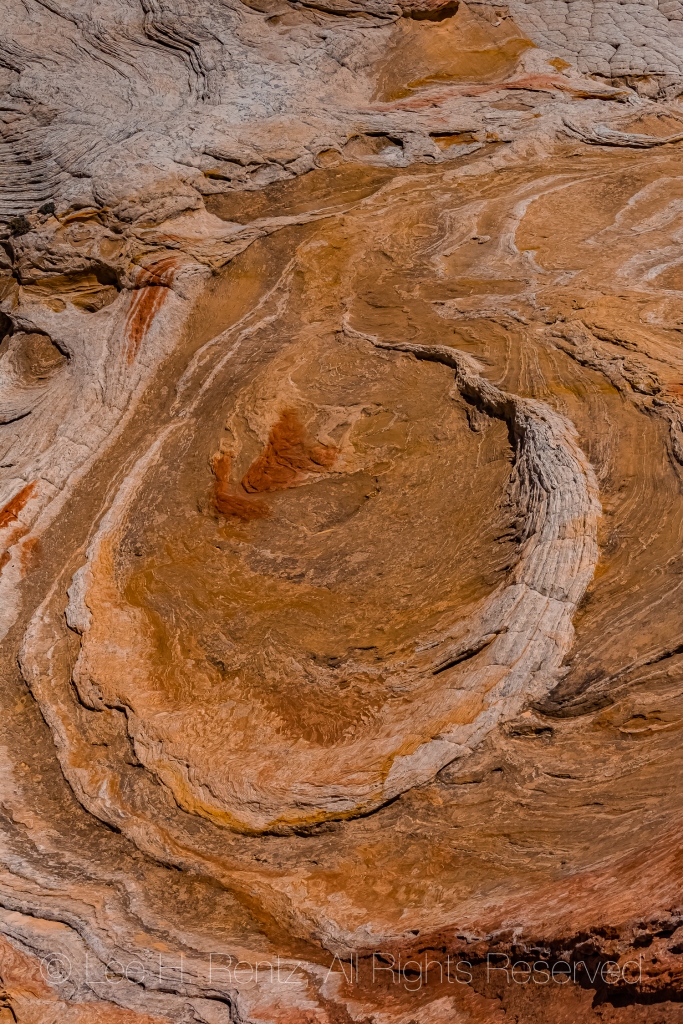Twisting and swirling, the red rock follows the random paths of a wild dream, then skirts a dome of white Navajo Sandstone cracked into nearly perfect polygonal plates, enchanting under a perfect sapphire sky. All of it originated 190 million years ago with a Jurassic sand dune that became saturated with groundwater, then experienced a sudden disruption–perhaps by an earthquake–that suddenly contorted the whole wet jumble while it had been hardening into sandstone. Incredible beauty resulted from this chaos.
Our time is short for exploring before the short period of golden light near sunset, so we walk around quickly to get a feeling for the whole area, which is about a square mile in size. An outfitter got us here and we have about 20 hours from mid-afternoon today to mid-morning the next day to explore and photograph before we have to leave. We are on our own, except that the outfitter provides dinner, a tent, and breakfast the next morning. The reason we came with a touring company is that we don’t have a rugged 4-WD vehicle to get us through the March mud quagmires and deep sand traps along the access roads. A tow out would cost $2,000 and is not covered by AAA. So here we are.
I once worked for the Bureau of Land Management on the Arizona Strip, a part of Arizona between the Grand Canyon and the Utah state line. This is an arid landscape that includes pockets of incredible beauty, such as Paria Canyon, The Wave, and White Pocket. When I was there with BLM in 1977, I was working as a writer and pen-and-ink illustrator for a book of wildflowers (still in print 43 years later!), but White Pocket was virtually unknown at the time, except for some ranchers and probably a handful of government employees. I certainly didn’t know about it and even if I did, my big Chrysler at the time couldn’t have dreamed of getting there. The name White Pocket originated from the desert term “pocket” which referred to a rock depression that can hold water–an important feature for cattle ranching and desert travelers. At that time the world hadn’t yet discovered much of the stunning beauty of red rock country. While at BLM, I heard the geologist for our district remark to my boss that he thought it was better in the desert when it was all considered a wasteland, and environmental regulations didn’t need to be followed. Fortunately, times have changed.
We spend the hours before dark exploring and photographing in great light, then walk back to camp for a meal of barbecued salmon or chicken or steak (another value in contracting with an outfitter!), then we venture back out into the contorted lands for hours of night photography. We return to camp sometime after midnight, then get up at 4 a.m. for dawn photography, so not much sleep. We stay until afternoon, delayed for a couple of hours by a vehicle problem, and we don’t mind the delay in the least, because it gives us more time to explore this place torn from time.
The photographs here give the visual story of White Pocket, which is the most stunning desert location we have visited.



























Rather than give you directions and maps and more cautions, I will refer you to three good websites that cover all that information. Be advised that there have been discussions at the Bureau of Land Management about requiring a permit so the area does not become overused, so make sure you check with them about current rules and regulations (and road conditions) before you attempt traveling to White Pocket.
The American Southwest–White Pocket
My work appears on my photography website: leerentz.com and on my Facebook page: Lee Rentz Photography

